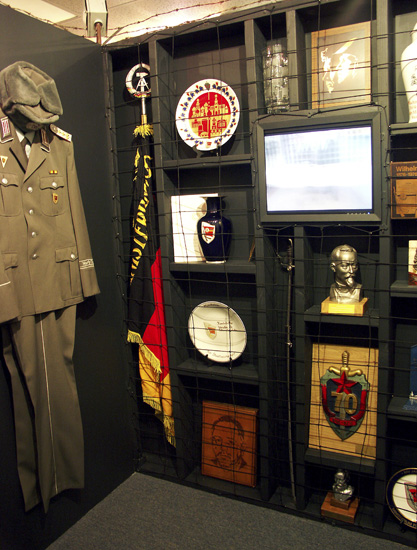Bruin brings Cold War to L.A.

The Wende Museum’s L.A. headquarters are located in Culver City, but there is another location in Berlin.
By Shirley Mak
April 1, 2009 9:40 p.m.
Many UCLA students are no strangers to visiting museums, given the abundant opportunities to visit them all across Los Angeles. But one alumnus took it a step further ““ he founded his own.
The Wende Museum, located in Culver City and founded by UCLA alumnus Justinian Jampol in 2002, is one of the few museums in the U.S. devoted solely to the exhibition and preservation of material culture from Cold War-era Eastern Europe, with an emphasis on life in East Germany prior to the fall of the Berlin Wall.
At first glance, both the location and subject matter of the museum fall outside of conventional expectations. After all, a museum located in sun-filled, Hollywood-driven Los Angeles devoted entirely to the Cold War seems anachronistic ““ even in a place as diverse as Los Angeles.
UCLA history Professor Teofilo Ruiz taught Jampol when he was an undergraduate at UCLA and now serves on the board of directors for the Wende Museum. Ruiz had a similar surprised reaction at the time of the museum’s founding.
“I thought he was crazy,” Ruiz said. “I didn’t think how he could ever do it, but he did. It was quite a remarkable achievement what he has done. He went to Europe to do work and began to collect his materials, and only by his incredible drive and ambition was he able to put together this museum. Some of my students have gone on to do very interesting things, but none of them at this age have gone out and founded a museum. (This) is certainly something that I have never seen.”
Today, the Wende Museum continues to flourish as a respected and sought-after institution by visitors and scholars alike. Unlike many other museums devoted to capturing East German culture during the Cold War, the Wende Museum’s abundant collections seek not only to convey the social, political and cultural aspects of the time period but also to present them in such a way that the material remains alive and relevant even in the 21st century.
For this reason, every object in the Wende collection, ranging from the folk paintings that adorn the main gallery to a faded shirt worn by a member of the Youth Organization in East Germany, has a specific story attached to it. These stories are accessible not only through the museum’s extensive database, which records nearly every known detail associated with the object, but are also present in the oral history component of the museum known as the Historical Witness Project, a film archive filled with the verbal contributions of the original owners.
“Oftentimes what we do after acquiring our major collections is that we’ll send somebody out there to speak with (the donors) and their families, and we’ll ask questions about how (the item) was acquired,” Jampol said. “We have four or five individuals who have spoken over 20 hours on film, so it’s really amazing. And that’s something very rare too. It takes a lot of work and a lot of research to track them down, get their stories and put them into the (database).”
UCLA Professor Lisa Parkes, who took her Advanced German Language class for a visit to the Wende Museum in 2006, was impressed by the way in which the museum broadly represents East German culture.
“Unlike other museums, the Wende Museum does not claim to reconstruct any kind of authoritative or “˜official history’ of the GDR; nor does the Museum fall into the “˜kitschy-memorabilia’ trap of focusing on everyday products that have been revived and popularized by post-Wende “˜Ostalgie’ (which is basically “˜nostalgia’ for the “˜East’),” Parkes said. “Rather, the museum offers a much more varied and nuanced look at GDR culture, with artifacts ranging from everyday life to the political that forces us to do the interpretative work ourselves … I have rarely witnessed students so enthralled by a museum.”
After seeing the exhibits with their own eyes, students from Parkes’ class presented their end-of-the-year projects at a symposium organized by the Wende Museum at the UCLA Library. Yet the universal appeal of the museum not only draws spectators from the classroom but those interested in working there as well. Currently, the Wende Museum has an internship program at UCLA that allows for students from all fields and backgrounds to pursue their own individual interests, whether it is in the realm of art history, cultural anthropology or sheer curiosity, while gaining hands-on museum experience.
“What I like about working here is that they really let you do whatever you want to do, which is cool,” said Megan Plato, a fourth-year anthropology student who currently works at the museum as a part of work-study. “You can help out with (a variety of) projects, and you get to learn a lot if you want to. People get to see the personal side of the Cold War and what it was like to live in Germany at that time. You definitely learn a lot about the museum atmosphere really quickly.”
The museum’s strong ties to UCLA stem from Jampol’s own intimate connections with the university.
“(UCLA) is a place where I was intellectually intrigued and inspired,” Jampol said. “There’s a lot of interaction between UCLA students (and the museum), and that’s important because the museum’s mission is very intellectually and academically rooted, so it makes a lot of sense to involve and engage students as much as possible.”


